
Tracing from 1898 OS map of central Harpenden, showing wells and pumps. Credit: Les Casey
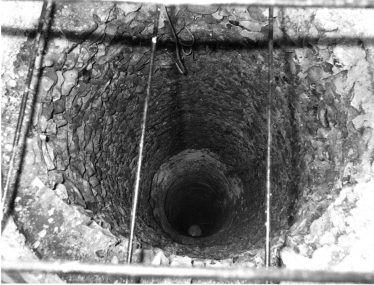
The well at The Dene, 15a Southdown Road. Credit: LHS archives – LHS 2299
Until 1885, all Harpenden’s water came from wells. The Ordnance Survey map of 1898 shows the locations of many of the pumps and wells which provided the residents with water, and there was also a role for water carts.
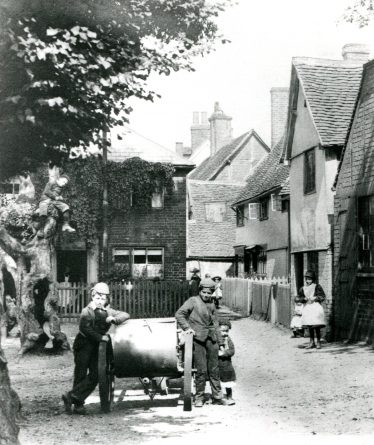
A water cart outside Lines forge in Lower High Street, c.1890. Credit: LHS archives – LHS 3482
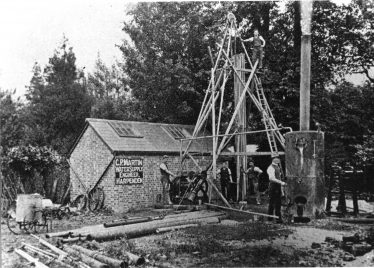
C P Martin, water supply engineer and well-borer. Credit: LHS archives – LHS 507
The well-borer Mr C P Martin remained in business until 1915. Some wells survived to be photographed … for instance at The Dene, 15A Southdown Road. Generally wells were operated by hand pumps, but the well at Annables Farm was operated by a.donkey. The well-head gear at upper Topstreet Farm (The Granary farm) in Crabtree Lane was substantial. It was moved to the Chiltern Open Air Museum in the 1970s when the site was prepared for the development of Gilpin Green.

Hand pump, Salisbury Road, Batford, 1970s. Credit: LHS archives – LHS 12697, L. Casey
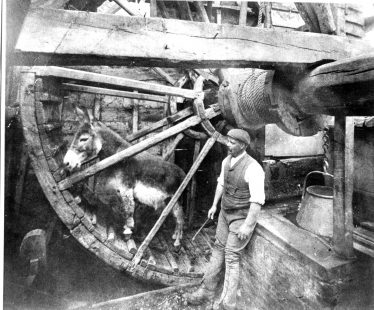
The Donkey wheel at Annables Farm, with Mr Welch. Credit: LHS archives – copy of F. Thurston photo – scan of LHS 12297
In 1885 a private company was formed to supply water to the new Park View Estate (Milton, Shakespeare, Spenser and Cowper Roads). The 1898 map shows the reservoir and water tower of the Harpenden Water Company in Shakespeare Road. Its first office was in the home of Mr C J Williams of 5 Milton Road. He moved the office to the premises of his coal merchant business in Station Approach, until c.1930 when the office moved to 33 High Street/29a High Street.

The first water tower, built in 1890. Credit: LHS archives – LHS 510/13417
The first tower dates from 1890, and stored 75,000 gallons of drinking water. However by this time the company was in financial difficulties, as demand for piped water had grown quickly. It was offered to Harpenden Parish Council in 1889 for £5000, but the offer was not taken up. Soon after Harpenden Urban District Council was formed in 1894, the Water Company again offered the company to the Council, this time for £13,550 (later reduced to £12,000), but still the Council refused to take it on, bowing to resistance to higher rates being charged. While one farmer, Mr Hitchcock, said he ‘would not object to a 1½ d (half a penny) rate for five years in order that the Parish would have control of its own water works’, another farmer, Mr Sibley, objected to farmers paying rates for benefits they did not get (as they had their own water supplies) and he made it clear that he would not pay.
In the event, Harpenden Water Company remained independent until it was taken over by the Colne Valley Water Company in 1960. Ownership of the company has changed name three times. In 1994 it became part of the Three Valleys Water Company and in 2010 it became Veolia, renamed Affinity Water in 2012. What is not disclosed is who actually owns the company since water was privatised in 1989.

Plaque on the pumping house, erected in 1913. Credit: LHS archives – copy from old negative -LHS 1249
In the absence of surviving records (there are none in the National Archives), we can guess that the second water tower and pumping station were erected in 1913 – according to the foundation stone on the pumping house building.
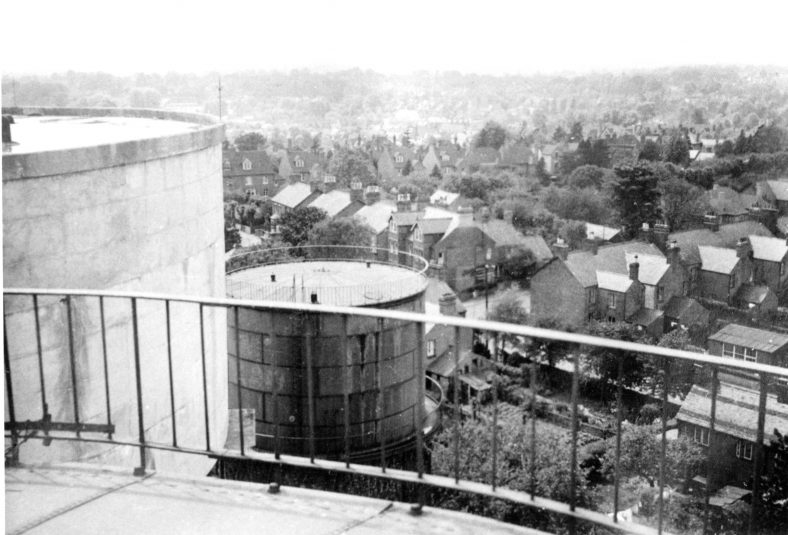
The first and third towers, viewed from the top of the second tower in 1932, – corrected in the light of the Comment below. Credit: LHS archives – copy of photo by F. Skeat -LHS 12176
With the expansion of Harpenden in the 1930s, a third water tower was built, and for a while there were three towers on the site – as evidenced from photographs taken in around 1932 from the top of the newly built tower with reinforced steelwork. It would appear that this was also the time when the Harpenden Water Company pumping station was built just south of Hyde Mill, drawing water from a deep bore hole near the River Lea.
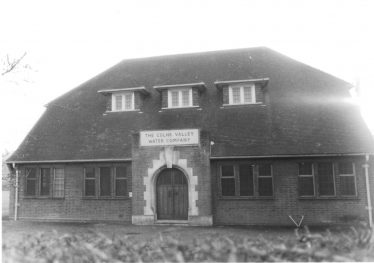
Harpenden Water Company pumping station on River Lea, East Hyde. Credit: LHS archives – LHS 3256
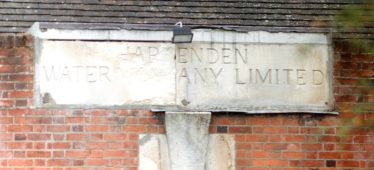
Harpenden Water Co, plaque, later changed to Colne Valley Water Co. Credit: LHS archives – LHS 10013
The company was evidently proud of the new tower, and published a photograph and summary of the specifications on stiff card, presumably as a promotional exercise to reassure the public of the engineering skills involved.
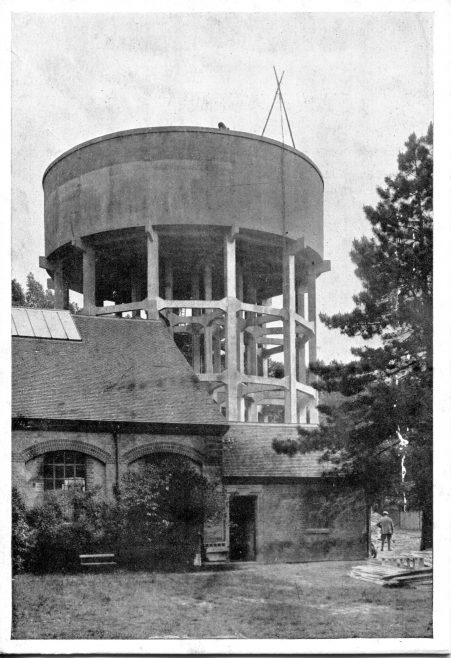
Promotional photo of the new tower, 1931. Credit: LHS archives
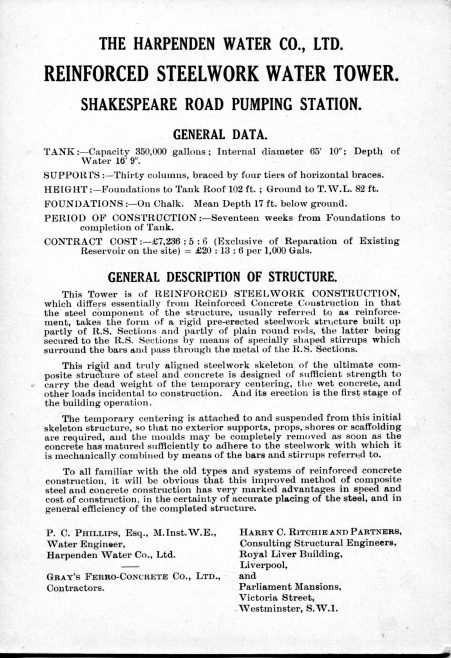
Specifications for the new tower on the promotional card. Credit: LHS archives
Sirens
During the second world war air raid sirens were situated at Abbott and Anderson’s factory, near the Silver Cup in Leyton Road, at Harris Builders at 100 Luton Road, and on the old water tower in Shakespeare Road – as recalled in various memoirs about the war.

The second tower (c.1913) and third tower (1931), from Granary Lane, 1965. Credit: LHS archives – LHS 509, LFC
The second tower was demolished in the late 1960s by D V Baulk.
During the 1960s a new or enlarged reservoir was dug alongside Granary Lane.
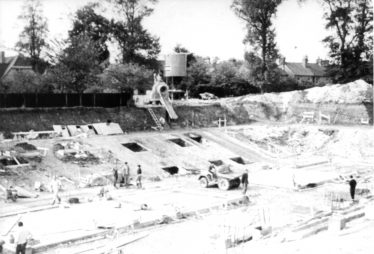
Excavating for the enlarged reservoir, c.1968. Credit: LHS archives – copied from a colour slide by LFC -LHS 2996
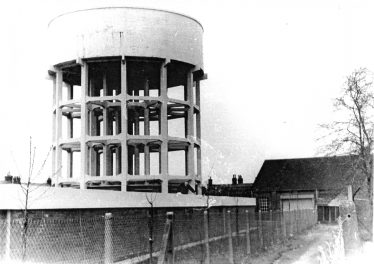
The completed reservoir, alongside Granary Lane, 1969. Credit: LHS archives – LHS 11558, LFC
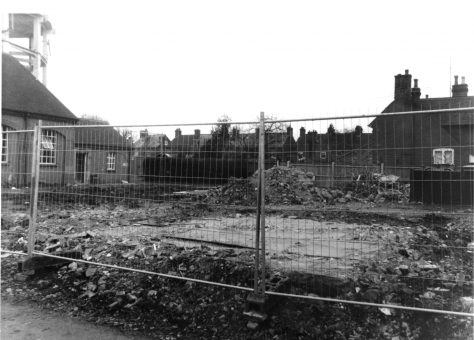
Site of the demolished wellhead building, 1997. Credit: LHS archives – LHS 5636, LFC

Harpenden Water Co. manhole cover, Cowper Road. Credit: LHS archives – LHS 12690, LFC

The water tower, seen from Harpenden Common in June 2014, showing antennae. Credit: Trevor Miller
With the advent of mobile phones, antennae were attached to the top of the tower. In May 2014 a planning application was submitted to St Albans District Council for the erection of a slender 20m galvanised steel tower specifically for antennae – “New Concrete Base And 20M Dual Use Lattice Tower With Six Antennas On Pole Mounts And Yolk Arms And Ancillary Cable Trays Mounted On Poles”.
Despite many local objectors, planning permission was granted, on appeal, at the end of December 2014. From the documentation it is apparent that Affinity Water had already planned demolition of the Water Tower which had not been in use for some time. The water works are not within the Conservation Area, and the Tower was not listed.
In January 2016, to the dismay of those who had not heard of the planning application and erection of the new mast, demolition of the Water Tower began and was photographed by many local people – there is a selection of photos recording the demolition between 27 January and 3 March 2016 in the gallery published on a linked page. The loss of a landmark has been much lamented through social media.

Comments about this page
Thank you for a most interesting and informative article. Regarding the demise of tower #1, it can still be seen standing in front of tower #3, along with tower #2, at the very top of this aerial photograph from 27th October 1952: https://britainfromabove.org.uk/image/eaw047649.
A 1:1,125 OS Plan from 1966 (https://www.old-maps.co.uk/#/Map/514138/214261/13/101329) shows only towers 2 & 3.
I believe the caption on the photo by F S Skeat – LHS 12176, should read “The new and the old towers, viewed from the top of the second tower in 1932” as I don’t believe you could photograph towers 1 & 2 from tower 3, unless you had an exceptionally wide angle lens. I believe the photographer is looking West and is elevated on tower 2, where we can see it’s roof railings (also seen on photo LHS 509, LFC). The new concrete tower is seen on the left and the iron tank of the first tower is in the centre of the picture. At its rightmost tip is the distinctive roof-line of the houses (? 14 & 16) on the corner of Shakespear Road and Cowper Road.
The third tower is believed to be the first of its kind, to use what is commonly referred to as the “Ritchie system” as detailed on the promotional card… This system was patented in 1924.
Ferrers
British Water Tower Appreciation Society (Archives)
http://www.bwtas.blogspot.co.uk
Add a comment about this page